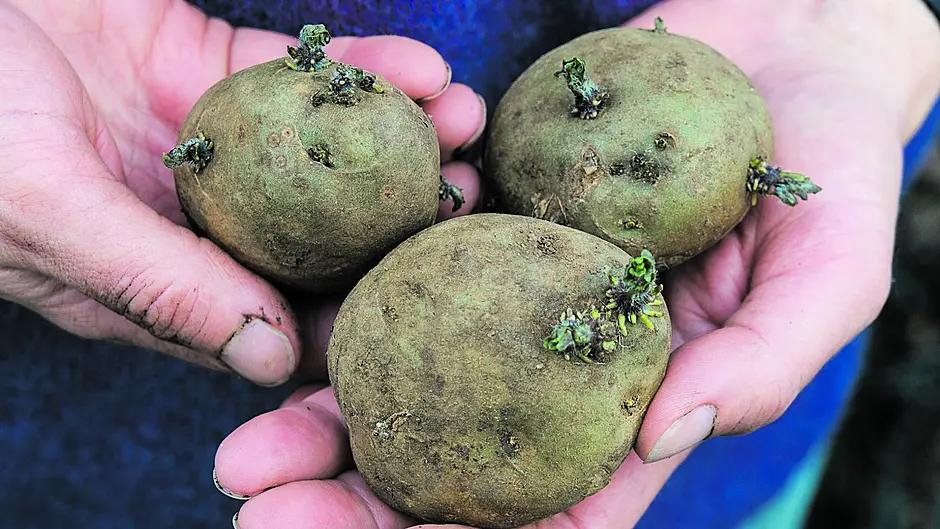BY JOYCE RUSSSELL
JANUARY can feel like a quiet month. The days are still short although we do begin to see them stretching out.
There’s promise in even a few minutes of extra light and plants start to respond long before we are aware of it.
There’s still plenty of cold weather to come, but any few days of warmer weather will get sap moving and, before we know it, early buds will start to burst.
Take care not to trample leaves of bulbs planted in lawns – if stems break, then there won’t be any flowers. It’s worth putting a few branches over the top if you need to protect areas against enthusiastic dogs and children.
Frosty sprouts
You may have picked most of your sprouts already, but don’t lift plants while there are still small balls at the top of stems. These tiny sprouts can be the tastiest treat – provided you have the patience for preparing them.
 Small sprouts are the sweetest at the top of stems.
Small sprouts are the sweetest at the top of stems.
Winter-hardy varieties of Brussels sprouts can stand for a few more weeks yet. However, I do find that if there are lots of hard frosts, the flavour can be affected. Some varieties suffer more than others and the bigger the sprouts, the more tasteless they seem to become. If there is a long spell of sub-zero temperatures forecast, it might be as well to pick and enjoy the harvest before they deteriorate. Or make a sprout curry where the reduced flavour doesn’t matter so much!
Beetroot
If you sowed these in a polytunnel or greenhouse in July or August, there should be some useable roots now. Don’t worry if they aren’t big enough – as long as plants are still healthy, and haven’t started to bolt, there is plenty of time for beetroot to grow bigger in the next few weeks.
Plants grown under cover tend to do better through the winter months than those sown outdoors. Leaves may suffer from leaf spot and roots may be nibbled by slugs – better ventilation and organic pellets can be the solution to these issues.
 Enjoy young beetroot from a summer sowing.
Enjoy young beetroot from a summer sowing.
Early seed potatoes
We know that there were problems with lifting commercial potato crops in Ireland because of the prolonged wet autumn weather. Irish grown seed potatoes and those from other countries like Scotland or Holland were also subject to inclement weather. All of which can lead to a shortage of supply of good quality seed potatoes.
Early varieties are available now. I got a delivery of my favourite Charlotte seed potatoes from Fruit Hill Farm, just before Christmas. This is earlier than I usually get them, but I’m delighted to have plenty of clean, healthy seed for planting in March.
Put potatoes to ‘chit’ as soon as you get them. Keep them in a cool frost-free place where there is plenty of light. The aim is to produce short, strong, green shoots rather than long white ones. The latter are vulnerable and often break when planting.
To’chit’, stand potatoes with the eye end up – look for small dimples with tiny buds at the base. You can stand the potatoes in egg boxes to achieve this, or pack them in a shallow box so they support one another. Shoots will grow from the eyes at the top of the potatoes. If the potatoes already have a few long white shoots, these can be removed, provided there are other eyes with small buds that are ready to grow. Shoots grow slowly so your seed potatoes won’t need planting out for a couple of months.
Keep your eye out for later planting varieties over the coming weeks. It’s worth buying seed when it is at its best.
In the greenhouse or polytunnel
The extra protection provided by a covered space helps you to extend the growing season. It may be cold outdoors, but the soil under cover will be a degree or two warmer. It’s worth sowing a row of salad leaves if the weather isn’t too cold. You can try some early peas and broad beans too, but be sure to sow a few extra in case some fail. You may need to cover rows with some horticultural fleece if temperatures drop
again.
If you plan to grow aubergines, make sure you buy seed now. You can sow in a pot on a warm window ledge to get young plants going. Cover the pot with a plastic bag and aim for a temperature around 20C.
A bit of trimming
You can trim hedges now, reshape straggling bushes, or remove any overhanging branches that interfere with your garden. You may even want to reduce the height of some trees if they overshadow your plot. It isn’t just light that’s an issue, a network of roots can be sucking out the goodness from your soil. Get expert advice if this is a major job!






